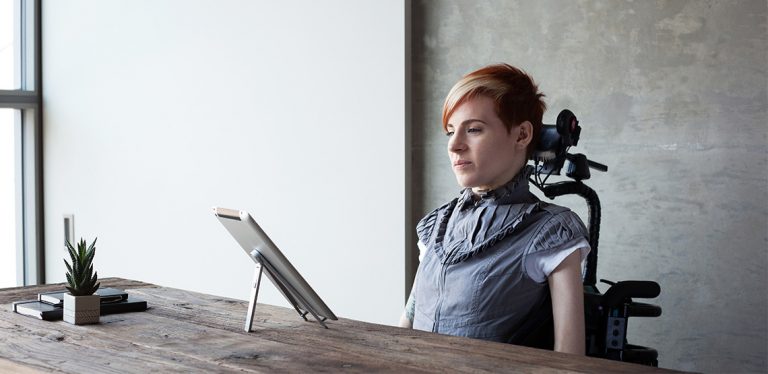Improving Lives
Switches. For individuals with an interest in gaming or electronics, this word has been used quite frequently recently by famous gaming consoles including Nintendo and Xbox. However, did you know that before they were made famous by the gaming industry, switches were (and still are) very important to individuals with disabilities?
Fun fact: The Nintendo Switch has nothing to do with accessibility switches, but the Xbox adaptive controller would not have been created without them.
What are Accessibility Switches?
Accessibility switches were created to help individuals with physical impairments have access to technology with whatever movement they have. Some switches, like a light touch button or joystick, only require minimal dexterity.
Others can be more complex, such as a proximity switch or a sip & puff switch, which are controlled by movement from a mouth or a blink of an eye. There is undoubtedly an accessibility switch for all persons with disabilities.
Accessibility Switches Can be Intimidating
While the concept of an accessibility switch can seem simple, it can be intimidating for individuals first being introduced to it. Nowadays with a single accessibility switch, users can control multiple devices and perform many tasks with them. They can make a phone call, send a text, control a TV and much more.
Before purchasing, there are plenty of different features to consider and a wide array of styles to choose from. Some users may only have one access point for mobility and will need to rely on device accessibility features such as auto-scan to make selections. This allows the user to choose different options automatically. Other users may have increased flexibility and therefore would be able to access multiple accessibility switches for device control.
Overall, it is completely up to the individual and their mobility.
Where Should Users Start When Selecting an Accessibility Switch?
Each accessibility switch can be configured to match the user's abilities, needs and lifestyle. Some of the many criteria to consider when selecting an accessibility switch include:
- Activation type: There are many ways that accessibility switches can be activated. Some include pressure, a lever, push or grip movement and proximity.
- Click feedback: How the individual knows that their movement was activated. Some require an audible beep or click, visual change or tactile response.
- Positioning: Consider where the switch will be placed for use since there are plenty of mounting options. Some examples include a mounting arm or Velcro.
- Activation surface: The area size that will be triggered by the user to make a selection. This feature is important because many individuals, depending on their diagnosis, have difficulty with small accessibility switches as they can be tricky to activate.
How do Accessibility Switches Allow for Technology Control?
Connecting accessibility switches to any device or electronic allows for complete and independent control. An everyday example of switch-activated devices includes remote controls, cameras, speakerphones or children's toys. For able-bodied individuals, all these examples include a button switch that allows for technology selection.
More complex devices include smartphones, tablets and computers, as these devices have switch-accessibility features in their software that are compatible with devices like tecla-e that allow them to connect with accessibility switches wirelessly.
The main accessibility feature that allows for increased control using accessibility switches allows users to scan their screen in two different ways: point mode and item mode.
Point Mode
Allows for control with two lines intersecting on a screen. One line will scan the screen horizontally until selected with the activation of a switch to stop. The other line will scan vertically in the same fashion until there is a point where they intersect in which the person controlling the accessibility switch(es) makes the selection on the screen.
Click here to see what this type of screen scanning looks like.
Item Scanning Mode
This method is the most simple and requires only one accessibility switch, although it works with more than one as well. Here, the items on the screen are either scanned in a row format and continually refined until the user makes a selection, or they are scanned individually as if they were in a continued line. Item scanning mode is better for individuals who have difficulty with timing or aim that would otherwise be required when making a selection using point mode.
Click here to see what this type of screen scanning looks like.
You May Also Like:
Related Search Topics (Ads)
Who Benefits from Accessibility Switches?
We have already mentioned that Accessibility Switches benefit individuals with limited physical mobility, but what are some diagnoses that this entails? Users who benefit from using accessibility switches include those living with:
- Multiple sclerosis
- Cerebral palsy
- Spinal cord injuries
- ALS
- Muscular dystrophy
- & much more
Meet Christopher — The Switch Control Expert!
Christopher lives with cerebral palsy and has become an expert at using accessibility switches. With the help of Tecla and Apple technology, he enjoys filming and editing movies by connecting to his computer and drone. Access to technology provided Christopher with the opportunity to show his creativity to the world and become an entrepreneur. Check out his switch control overview on YouTube for more information.
What about the Nintendo Switch and Xbox Adaptive Switch Controller?
The Nintendo Switch got its name to signify the switch in gameplay from a television to the Switch handheld screen. Unfortunately, the Nintendo Switch does not have many accessibility features that could help users with mobility impairments. *Thumbs Down*
On the other hand, the Xbox adaptive controller was originally created to allow veterans who had difficulty holding a gaming remote to access an Xbox. Now users are able to plug in their desired accessibility switches to re-create the control of the original handheld controller. Now this controller is offered worldwide and has gained plenty of awareness from their empowering Superbowl commercial featuring impaired children having the opportunity to feel included by gaming with their peers. *Thumbs Up*
Comparative to the Xbox adaptive controller that allows users to experience gaming, the tecla-e enables individuals to use accessibility switches to control up to eight different smart devices at a time! This could include their lights, television, Kindle app, tablet and much more! For example, users who cannot hold a phone can send text messages and make phone calls using the Tecla, accessibility switches, and switch control modes on their iOS devices. *Two Thumbs Up*
Next time there is an advertisement for the Xbox adaptive controller or Tecla, be reminded of the many individuals around the world who are dependent on these devices for independence and how important they are for technology access.
Learn more about how Tecla is helping people gain independence with their assistive device here.

